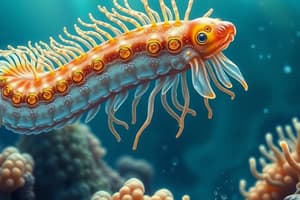Podcast
Questions and Answers
Which type of reproduction involves a single parent and does not require gamete fusion?
Which type of reproduction involves a single parent and does not require gamete fusion?
- Asexual reproduction (correct)
- Bisexual reproduction
- Heterogamy
- Sexual reproduction
Which term describes the first menstrual period in females?
Which term describes the first menstrual period in females?
- Spermatogenesis
- Menarche (correct)
- Gamete formation
- Oogenesis
What structure in angiosperms develops into fruit?
What structure in angiosperms develops into fruit?
- Sepal
- Ovary (correct)
- Stamen
- Petal
Which type of sexual reproduction involves the fusion of similar gametes?
Which type of sexual reproduction involves the fusion of similar gametes?
What is the primary purpose of chlorophyll during the light-dependent reactions of photosynthesis?
What is the primary purpose of chlorophyll during the light-dependent reactions of photosynthesis?
What type of organism can undergo self-fertilization, having both male and female reproductive organs?
What type of organism can undergo self-fertilization, having both male and female reproductive organs?
What process involves the growth of a new organism from an outgrowth of the parent?
What process involves the growth of a new organism from an outgrowth of the parent?
In which type of asexual reproduction does a single cell split into two?
In which type of asexual reproduction does a single cell split into two?
Which category of fungi is known to have a symbiotic relationship with algae?
Which category of fungi is known to have a symbiotic relationship with algae?
Which of the following is an example of regeneration in animal biology?
Which of the following is an example of regeneration in animal biology?
Flashcards are hidden until you start studying
Study Notes
Annelids vs. Arthropods
- Annelids lack jointed legs; arthropods possess jointed legs.
- Annelids have a true body cavity, while arthropods feature a false body cavity filled with blood.
- Annelids do not have a chitinous exoskeleton, in contrast to arthropods, which do.
Plant Classification
- Plants are classified based on evolutionary and genetic relationships.
- Vascular plants possess a vascular system and are more diverse; they withstand drought.
- Non-vascular plants lack a vascular system and are usually tender and shorter; they are often found near water sources.
Plant Types
- Gymnosperms are non-flowering, cone-bearing plants with unenclosed seeds and needle-like leaves.
- Angiosperms are flowering plants with seeds enclosed in an ovary and have flat leaves.
- Monocots have one cotyledon, fibrous roots, and flower parts in multiples of three.
- Dicots have two cotyledons, taproots, netted leaf veins, and flower parts in fours or fives.
Plant Parts and Their Functions
- Roots anchor the plant and absorb water and minerals.
- Stems provide support and transport nutrients.
- Leaves are the site for photosynthesis, containing chlorophyll.
- Flowers serve as reproductive organs, containing both male and female structures.
- Fruits develop from fertilized ovaries, protecting and dispersing seeds.
- Buds are undeveloped shoots that can grow into leaves or flowers.
Plant Tissues
- Dermal tissue forms the protective layer of the plant.
- Ground tissue is involved in metabolic functions like photosynthesis, consisting of parenchyma, collenchyma, and sclerenchyma.
- Vascular tissue transports minerals, water, and food through xylem and phloem.
- Meristematic tissues allow for growth in height, internode length, and girth.
Root Systems
- Taproots are thick and grow vertically; adventitious roots arise from other plant parts.
- Fibrous roots create a dense network to prevent soil erosion; stilt roots support plants like bamboo.
- Aerial roots grow above ground, while floating roots adapt to aquatic life.
Stem Types
- Woody stems are tough and thick, common in trees and shrubs.
- Herbaceous stems are soft and green, found in non-woody plants.
Plant Life Cycle
- Annuals complete their life cycle in one season; biennials take two years; perennials live longer.
Modified Stems
- Rhizomes are underground horizontal stems; bulbs store food, and corms are solid modified leaves.
- Tubers (like potatoes) are storage structures, while runners produce new plants.
- Suckers arise underground, and tendrils assist in vegetative reproduction.
Leaf Anatomy
- Axil refers to the angle between a leaf stalk and the stem; midrib is the main vein of a leaf.
- Leaf shapes include oval, cordate, and spatulate; margins can be entire, toothed, or lobed.
Photosynthesis
- Photosynthesis produces glucose and oxygen while requiring carbon dioxide, water, and sunlight.
- The process includes light-dependent reactions and the Calvin cycle, encompassing carbon fixation and regeneration phases.
Plant Development Phases
- Sporophyte is diploid, while the gametophyte is haploid, consisting of male (microspores) and female (megaspore) gametophytes.
Modes of Plant Nutrition
- Autotrophs produce their own food; heterotrophs rely on others for nutrients.
Root Interactions
- Roots interact with mycorrhizal fungi, facilitating nutrient absorption.
Adaptations
- Parasitism (e.g., dwarf mistletoe) and predation (e.g., Venus flytrap) are examples of plant adaptations to optimize survival.
Gas Exchange Mechanisms
- Stomata in leaves, lenticels in stems, and root hairs play roles in gas exchange.
Plant Tropisms
- Tropisms are responses to stimuli; types include geotropism (gravity) and phototropism (light).
Plant Hormones
- Various hormones regulate growth and development, including auxins, gibberellins, and ethylene, affecting processes like germination and fruit ripening.
Transpiration Factors
- Transpiration involves root pressure, capillary action, and transpiration pull, facilitating water movement in plants.
Plant Propagation Methods
- Techniques include selective breeding, hybridization, and artificial selection to enhance desirable traits in plants.
Reproductive Strategies
- Modes of reproduction include oviparous (egg-laying), ovoviviparous (egg-hatching inside the body), and viviparous (live birth).
Classification Domains
- Carl Woese classified all life into three domains: Archaea, Bacteria, Eukarya.
Gamete Biology
- Sperm are the smallest cells, while ova are the largest; they carry haploid genetic material.
Reproductive Types in Organisms
- Sexual reproduction involves the fusion of gametes, while asexual reproduction does not. Various forms include budding and fission.
Studying That Suits You
Use AI to generate personalized quizzes and flashcards to suit your learning preferences.




